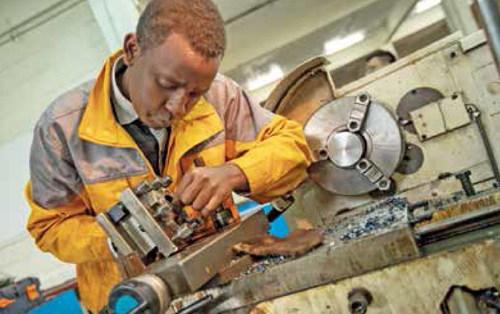互学互鉴 打开世界一扇窗
2019-09-10向雯
向雯

阿根廷学生在2018年中国高等教育展上咨询留学中国事宜

西北农林科技大学的留学生在上汉语课
绿草如茵,湖波微漾,在宁静的牛津市郊,一座古老的英式庄园静静地见证着这里百年的时光。这座名为福克斯康贝的庄园毗邻英伦名校牛津大学,如今,这里已被“北京大學汇丰商学院牛津校区”的名字所取代。
彼时,远渡重洋赴英留学的北京大学首任校长严复不会想到,140多年后,北大将在这片他求学的土地上开启崭新的征程。英国《卫报》评论称,北大开设汇丰商学院牛津校区是“大胆的一步”,也是“中国高等教育发展的一个重要里程碑。”
与中国经济机构对全球资源的整合相比,中国教育的国际化发展明显滞后。如今,北京大学汇丰商学院牛津校区的建立,成为了中国大学在海外独立建设、自主管理、实体办学的“第一单”,这也被看作是中国高等教育“走出去”的一个标志。
购置校区,自主管理,独立运行,招收国际学生……这一系列开创性的举措无不彰显出北大走向国际化的决心。北大汇丰商学院院长海闻表示,“教育的全球化,不仅仅是国外高校到中国办学,中国高校也会出国办学。北大汇丰商学院此次在牛津开办分校,对于整个中国教育走出国门来说,也是一个积累经验的过程。”
众所周知,英国是参与“一带一路”建设国家中教育水平最高的国家之一,也是世界教育强国,在这儿建校区也就意味着与众多世界名校有了更多交流互鉴的机会。
校园里,灰褐色的塔楼上高高悬挂起北京大学的校徽,登上塔楼,便可以看到如画的风景和远处的牛津大学,未来,不同国家的学子们将在这宁静惬意的校园中开启他们的学习之旅。
北大方面表示,汇丰商学院牛津校区的课程将重点关注“中国经济、金融市场与企业管理”,学院采用与中国本部接续培养的模式,给予学生充分了解中国的机会,在这里,学生们不仅可以学习到专业理论基础知识,还可以近距离地观察中国的改革发展实践。
近年来,像北大一样,许多中国学校纷纷尝试“走出去”。如厦门大学马来西亚分校、老挝苏州大学等,据数据统计,截至2018年上半年,有20个省份的80所高校开展境外办学,境外办学机构和项目近130个。
与“走出去”相比,引进外来优质教育资源,特别是加大从“一带一路”参与国家中引进优质教育资源的力度是近年来中国教育对外开放的一个显著特点。西交利物浦大学、上海纽约大学、宁波诺丁汉大学、北京航空航天大学中法工程师学院等学校都已成为“引进来”的精品项目。
据中国高等教育学会中外合作办学研究分会理事长、厦门大学中外合作办学研究中心主任林金辉介绍,截至2018年8月,国内有约2340个中外合作办学机构或项目,包括高中在内的中外合作办学在读生约60万人,其中高校在读约50万人,已从各类中外合作办学机构或项目毕业约160万人。
早在2016年7月,教育部就印发了《推进共建“一带一路”教育行动》,提出聚力构建“一带一路”教育共同体,不断推进沿线各国人民相知相亲。随着“一带一路”倡议不断深化,教育领域的合作已成为中外学子友谊的桥梁。
写春联,包饺子,勾年画,描书法……一群来自世界各地的留学生1月23日在湖南长沙体验着浓浓的中国年味。“新的一年,我的愿望是好好读书,也希望多哥和中国的友谊更加浓厚。”在完成人生中第一副春联后,来自多哥共和国的阿穆苏,爱科许下自己的新年愿望。
“春节”这个节日,对于爱科来说并不陌生,在中国,他已度过四次中国新年。2012年,爱科来到长沙理工大学攻读土木专业,2017年毕业后回国工作,2018年他又考上了长沙理工大学的研究生。“再度来到中国,除了想学习更多专业知识之外,更让我难以割舍的是6年来在中国结交的朋友和自己的中国情结。”爱科真诚地说,中国发展得很好,随着对中国的不断了解,他对中国传统文化的兴趣越来越浓厚。
正在北京体育大学读研究生的艾比来自挪威,她最大的愿望就是毕业后回到挪威推广中国武术。她说:“在挪威现在没有很多人练武术,我先在中国上研究生,学好后再回去推广。
位于东南欧的内陆国摩尔多瓦,对中国人来说也许不太熟悉。通过独联体国家互换奖学金项目,姚美玲来到这里留学。她说,希望通过留学让更多的中国人了解摩尔多瓦,也让摩尔多瓦民众对中国有更多的了解……
近些年,越来越多的海外留学生把中国作为留学的首选项,也有越来越多的中国留学生走进了“一带一路”沿线国家。据教育部数据显示,2017年,赴中国的“一带一路”沿线国家留学生为31.72万人,占总人数的64.85%;中国赴“一带一路”沿线国家的留学人数为6.61万人,比上年增长15.7%。
对此,中国与全球化智库副主任兼秘书长苗绿认为,一方面是中国的政策和机制性鼓励。中国教育部及各级教育系统出台了一系列指导性文件,推进与“一带一路”相关国家的教育合作;另一方面是奖学金支持,此外还有接近中国语言和文化的机会。随着中国经济的崛起和国际影响力的提升,全球掀起了一股“汉语热”,许多国家和地区的人们渴望学习中国语言和文化,提升个人发展空间,拓展商业合作潜力。
不久前,中原石油工程公司沙特中国1号钻井队迎来第100批沙特籍大学生实习生团,这些来自沙特各石油专业院校的大学毕业生在中国井队开始了职业生涯的第一站。作为沙特阿美公司大学生实习基地,该队近10年来已为沙特当地输送合格钻井人才1000余人。
“师傅,没有你就没有我今天的成就。”中原石油工程公司非洲项目部757钻井队平台经理左军卫意外地与当年的外籍同事——来自苏丹的穆罕默德·达毋在井场重逢了。
当初达毋从苏丹喀土穆大学石油工程专业毕业后,在左军卫所在井队工作,由于缺乏实际经验,很多活儿干不了。左军卫手把手地教他现场操作技术,达毋仅用半年时间就成长为带班队长。如今他已成为苏丹国内一支钻井队的平台经理。
实践是最好的老师,从第一线的工作岗位上,最能迅速地反映出企业需要的人才。随着“一带一路”建设如火如荼,专业技术人才需求日益增加,越来越多的高校也做出了新选择,江苏大学、中国地质大学(武汉)、对外经济贸易大学等很多高校都结合自身优势,精准发力,通过成立“丝绸之路学院”、对口办学、校企合作等方式,为“一带一路”建设输送国际化人才。
肯尼亚留学生卡里乌就是带着“目的”来北京交通大学学习的。在卡里乌的家乡修建的蒙内铁路,正是“一带一路”倡议下,中肯两国合作的旗舰项目。根据与承建方中国路桥公司的协议,北京交通大学负责为蒙内铁路培养本土化建设、运营与管理人才。这个名叫卡里乌的小伙子,就是从第二批报名的500多人中脱颖而出的35位佼佼者之一。
“肯尼亚跟中国的关系很好,所以中国一直帮助肯尼亚。毕业回国后,使用我们在中国获得的知识,改善我们的交通状况,对肯尼亚的发展有极大的好处。”卡里乌说道。
北京交通大学国际教育交流中心处长刘彦青表示:“我们培养的学生,既了解中国的国情,又懂汉语,所以在两国之间交流的时候,往往他们就会发挥作用。比如,蒙古学生阿图尔毕业以后,中蒙之间交通运输合作项目,他都会参与,2012年他成为了蒙古最年轻的铁道司司长。未来我想随着高铁项目的落地,可能会有越来越多的学生选择铁路方面的专业。”
高层磋商、合作办学、行业人才培養、建立高端智库……通过这一项项创新的举措,中国与“一带一路”沿线各国一道,通过教育领域的合作交流,不断培养出高素质人才,推动了沿线国家经济社会发展,也让教育真正成为“一带一路”倡议下最大的民心工程。

Century-old Foxcombe Hall,located in a suburbof Oxford, enjoys a carpet of green grassland anda picturesque lake. Neighboring the world-renownedUniversity of Oxford, the English manor is nowhome to the Oxford Campus of the Peking UniversityHSBC Business School (PHBS).
Maybe it never crossed the mind of young YanFuwho studiedin the UK 140 years ago and thenbecame Peking University's first principal-thatPeking University could start a new journey in thenation where he studied. The Guardian describesthe establishment of the Oxford Campus of PHBSas“a bold step” and “an important milestone for thedevelopment of China's higher education”.
The internationalization of Chinese educationalinstitutions clearly lags behind, compared withChinese economic institutions, which have a proventrack record in integrating global resources. Currently,the Oxford Campus of PHBS has been established.It is not only the first achievement of a Chineseuniversity to establish, manage, and operate anoverseas campus on its own, but also a milestone ofChinese higher education “going global”.
Peking University has made a series of pioneeringmoves, including purchasing the campus site,ananging independent management and operation, andrecruiting students from all over the world. A11 thesedemonstrate the determination of Peking Universityto become an intemational seat of learning. Hai Wen,dean of PHBS, said, "The internationalization ofChinese education means both welconung overseasuniversities to establish branch campuses in China,and encouraging Chinese universities to set upoverseas campuses. The establishment of the OxfordCampus of PHBS will lay a comerstone for Chineseuniversities in that regard."
It is known that the UK carries the highest cachetin education, not only among the Belt and Roadcountries. but also all over the world. Therefore,establishing a campus in the UK will bring moreopportunities for mutual learning with world topuniversities.
When you step in the campus, a taupe tower witha breathtaking panorama of surrounding countrysidescenery and the University of Oxford at the distancewill strike the eye, where the crest of PekingUniversity takes pride of place. In the future, studentsfrom different countries and regions will study at thisquiet and scenic campus.
According to the Peking University,PHBS UKcampus will focus on "Chinese economy, financialmarket,and business administration" in curriculumplanning, and will adopt the training mode underwhich students will have opportunities to study inthe main campus in China so as to make them tofully learn about this country. In this way, PHBSUK campus can not only prepare the ground of professional theories and knowledge for students,butalso offer them close-up insights into China's practicesin reform and development.
There is no doubt that Peking University is justone of many Chinese universities “going global”over recent years. The Xiamen University MalaysiaCampus (XMU Malaysia) and Soochow University,Laos (SUL) are such examples. According torelevant statistics, by the end of the first half of 2018,80 Chinese higher education institutions from 20provinces have run overseas campuses with nearly130 educational institutions and programs.
Apart from “going global”, introducing qualityforeign educational resources from Belt and Roadcountries into China with greater effort is anotherhighlight of the openness of Chinese education inrecent years. Xi'an Jiaotong-Liverpool University(XJTLU), New York University Shanghai (NYUShanghai), University of Nottingham Ningbo China(UNNC), and Ecole Centrale de Pekin (ECPk) aresome of the successful examples of“brining in”.
According to Lin Jinhui, director of Branch forChinese-Foreign Cooperation in Running Schools,China Association of Higher Education (BCFCRS,CAHE), and director of Center of Research onChinese-Foreign Cooperation in Running Schools,Xiamen University (CRCFCRS), by August 2018,there has been around 2,340 educational institutionsor programs jointly run by Chinese and foreigneducational institutions in China, delivering educationto about 600,000 students now including high schoolstudents and about 500,000 college students andtraining l.6 million graduates in total by now.
In July 2016, the Ministry of Education of thePRC (MOE) issued the Education Action Plan forJointly Building the Belt and Road Initiative,in whichit proposed to jointly build a Belt and Road educationcommunity, so as to enhance people-to-people bondsamong Belt and Road countries. As the Belt and RoadInitiative keeps breaking new ground, educationalcooperation has helped build bridges between Chineseand foreign students.
On January 23, a group of foreign students fromall over the world were celebrating Spring Festivalin Changsha, Hunan, by writing couplets, makingdumplings, drawing New Year pictures, and makingChinese calligraphy, experiencing the Chinese NewYear festivity in the air. "My wish for the new yearis to study hard, and to witness a stronger friendshipbetween China and the Republic of Togo," saidAmoussou Ekoe, an overseas student from theRepublic of Togo, afier finishing his first-ever couplets.
Ekoe is familiar with "Spring Festival", ashe has celebrated the Chinese New Year in Chinafor four times. In 2012, he came to ChangshaUniversity of Science & Technology (CSUST) tostudy civil engineering, and went back to Togo in2017 after graduation. In 2018, he was admitted as apostgraduate student of CSUST. "The reason why Ichoose China again is partly because of my thirst formore knowledge in this field. But what matter to meeven more are the friends that I made in China andmy attachment to China over the past six years," saidEkoe sincerely. He also added that China is gainingmomentum. The more he knows about China,themore he likes traditional Chinese culture.
Unlike Ekoe, postgraduate student Abby'sbiggest wish is to promote Chinese martial art in herhomeland Norway after she graduates from BeijingSport University (BSU). "Because most Norwegianpeople know little about Chinese martial art, I hope Ican do my bit in promoting this traditional art in myhomeland. That is why I am doing a postgraduateprog/am in China," She said.
Maybe Chinese people don't know much aboutthe Republic of Moldova, an inland country inSoutheast Europe, but Yao Meiling chose to study inthis distant nation through the scholarship exchangeprogram with Commonwealth of Independent States.Yao said,the reason why she chose to study in theRepublic of Moldova is that she hopes to help enhancemutual understanding between the two peoples.
Recent years have witnessed a growing numberof both foreign students who regard China as the firstchoice for overseas study and Chinese students whochoose to study in other Belt and Road countries.According to statistics from the MOE. in 2017,the number of students from other Belt and Roadcountries studying in China reached 317,200,accounting for 64.85% of Chinese total foreignstudents; the number of Chinese students studying inother Belt and Road countries recorded 66,100, up15.7% over the past year, a percentage higher than theoverall growth rate of Chinese overseas students.
Dr. Miao Lyu, vice president and secretarygeneral of Center for China and Globalization (CCG) held that, these trends can be attributed to two factors.First, China has offered a series of policies-relatedand institutional incentives. MOE and other Chineseeducation authorities at all levels have produced abatch of guiding documents to promote educationalcooperation with other Belt and Road countries.Second, China has offered scholarship and improvedaccess to learning about Chinese language andculture. With China's rise in both economic strengthand intemational influence, Mandarin is sweeping theworld. Many people from worldwide countries andregions want to expand individual development spaceand business cooperation potential through learningChinese language and culture.
Lately, the lOOth batch of Saudi Arabianpetroleum students from different colleges oruniversities in Saudi Arabia joined the No. I drillingcrew of Sinopec Zhongyuan Petroleum EngineeringCo., Ltd. as the first stop of their internship. Asthe internship site for university students for SaudiArabian Oil Company, the No. I drilling crew haschanneled more than l,000 qualified drilling talents toSaudi Arabia over the past ten years.
"Mr. Zuo, without you, I wouldn't have gottenwhere I am now," said Mollanmed Dau from Sudanwhen he encountered Zuo Junwei. his former mentorand now manager of drilling platform for No. 757drilling crew of African Projects Department ofSinopec Zhongyuan Peb01emn Engineering Co., Ltd.at the well site.
Back then, Dau worked in Zuo's team, aftergraduating in petroleum engineering from theUniversity of Khartoum in Sudan. As a green hand,inexperienced Dau was not competent in many aspectsof work. However, thanks to Zuo's patient teaching ofonsite operation techniques, Dau became a team leaderwitlrin just half a year. Now, he is a manager of drillingplatform of a Sudanese drilling crew.
As the old saying goes, practice is the best teacher.Positions at the production line always can fastestshow what kind of talents are needed by enterprises.As the Belt and Road Initiative gains momentum,there is an increasmg need for teclrnician personnel,so more universities have made new moves. Withrespective strengths in nuncL Jiangsu University, ChinaUniversity of Geosciences. University of IntemationalBusiness and Economics and other universities havemade targeted efforts by establishing Silk RoadInstitute, running colleges based on the needs ofjobs, and launching cooperation between universitiesand enterprises, in a bid to produce intemationalizedtalents for the Belt and Road Initiative.
This is also the reason why the Kenyan studentCariou chose to study in the Beijing JiaotongUniversity. Cariou's hometown is along the Mombasa-Nairobi Railway, one of the flagship projects under theBelt and Road Initiative. According to the agreementbetween the project builder,China Road and BridgeCorporation (CRBC), and Beijing Jiaotong University,Beijing Jiaotong University shall train talents forlocalized construction, operation and management forthe Mombasa-Nairobi Railway. Cariou is one of the35 students who stood out among the second batch of500 applicants.
"Kenya has been on good terms with China,and China is always willing to help Kenya. Aftergraduation, we will come back to Kenya, to improvethe transport condition of our motherland with theknowledge we have acquired in China. This willcertainly contribute greatly to the development ofKenya, " said Cariou.
Liu Yanqing, director of Center for IntemationalEducation and Exchange Center of Beijing JiaotongUniversity, said that “Our students not only knowthe conditions of China, but also speak Mandarin.Therefore. they will play their roles in China-Kenyaexchanges. For example, after graduation, Mongolianstudent Artur has participated in all China-Mongoliacooperation transportation projects. In 2012, hebecame the youngest section chief in the railwaysector of Mongolia. As more and more high speedtrain projects are launched in the future, I believemore students may choose the majors related to therailway sector.”
China has joined hands with other Belt and Roadcountries in many innovative moves, including high-level negotiation, jointly-run schools, talent trainingfor specific sectors, and establishing top-level thinktanks. These efforts have enhanced educationalcooperation and exchange among countries,continuously provided high-quality talents, andadvanced the economic and social development ofBelt and Road countries. In addition, China has alsomade education as the most significant project in thepublic interest, under the Belt and Road Initiative.
